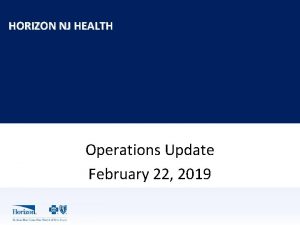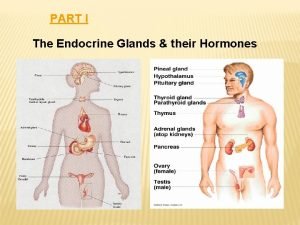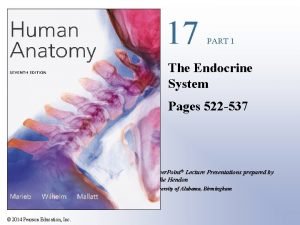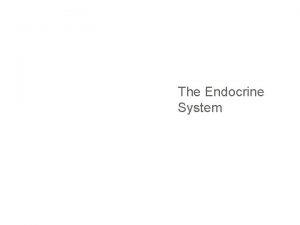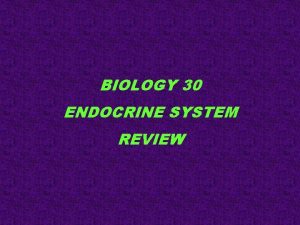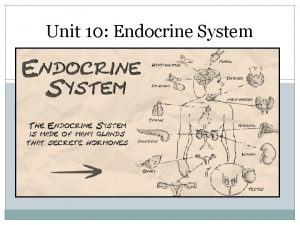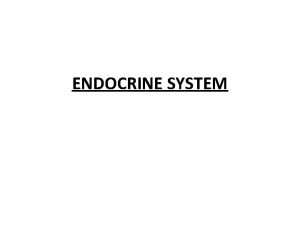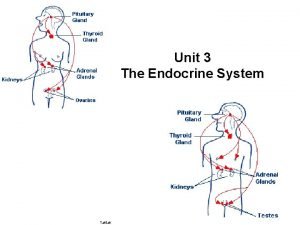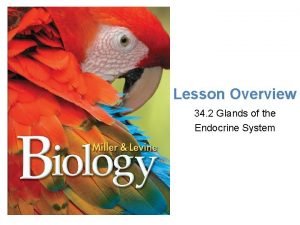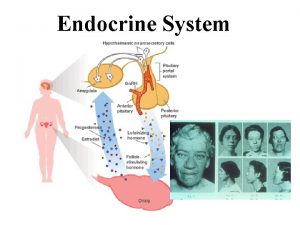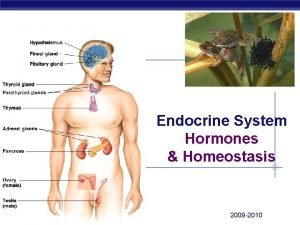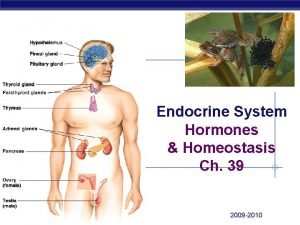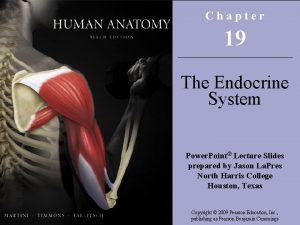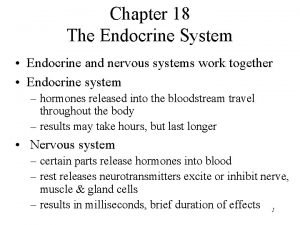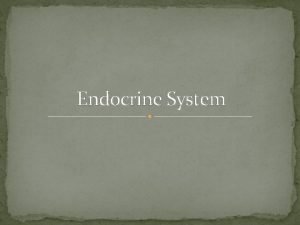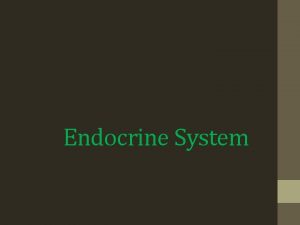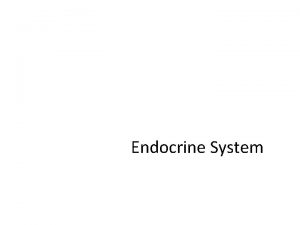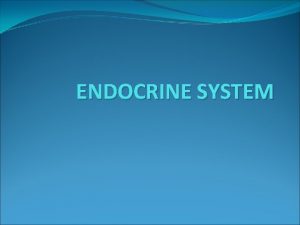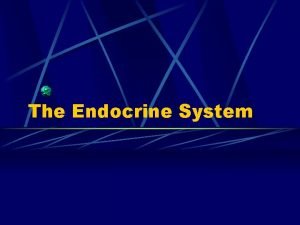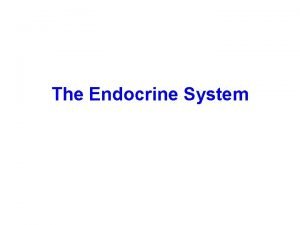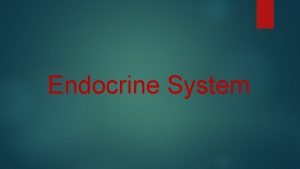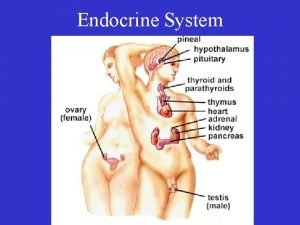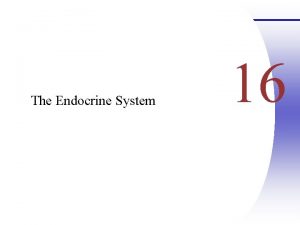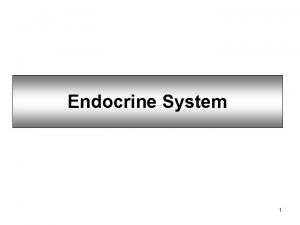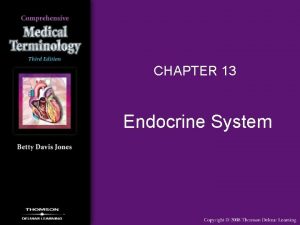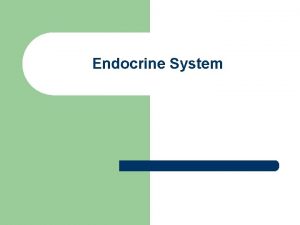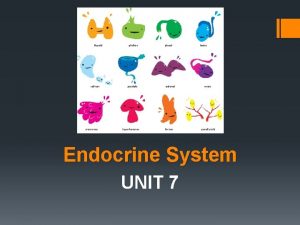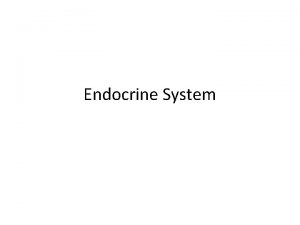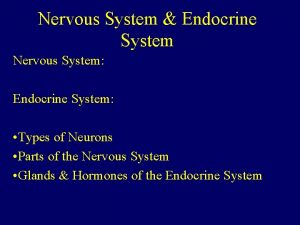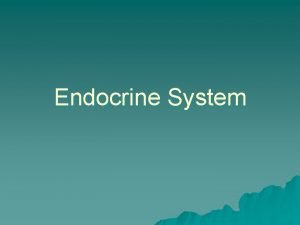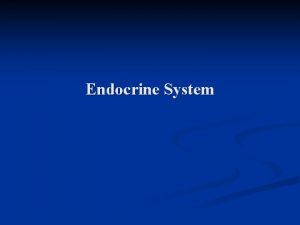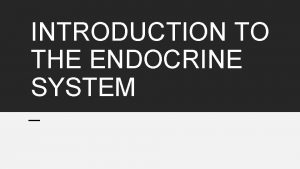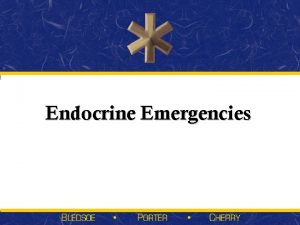17 PART 1 The Endocrine System Pages 522
























































- Slides: 56

17 PART 1 The Endocrine System Pages 522 -537 Power. Point® Lecture Presentations prepared by Leslie Hendon University of Alabama, Birmingham © 2014 Pearson Education, Inc.

The Endocrine System: An Overview • A system of ductless glands • Secrete messenger molecules called hormones • Interacts closely with the nervous system • Endocrinology • Study of hormones and endocrine glands © 2014 Pearson Education, Inc.

Endocrine Organs • Scattered throughout the body • Pure endocrine organs • Pituitary, pineal, thyroid, parathyroid, and adrenal glands • Organs containing endocrine cells • Pancreas, thymus, gonads, and the hypothalamus • Hypothalamus is a neuroendocrine organ • Produces hormones and has nervous functions • Endocrine cells are of epithelial origin © 2014 Pearson Education, Inc.

Location of the Major Endocrine Glands Pineal gland Hypothalamus Pituitary gland Thyroid gland Parathyroid glands (on dorsal aspect of thyroid gland) Thymus Adrenal glands Pancreas Ovary (female) Testis (male) © 2014 Pearson Education, Inc. Figure 17. 1

Hormones • Classes of hormones • Amino acid–based hormones • Steroids—derived from cholesterol • Basic hormone action • Circulate throughout the body in blood vessels • Influences only specific tissues—target cells • A hormone can have different effects on different target cells © 2014 Pearson Education, Inc.

Control of Hormones Secretion • Secretion triggered by three major types of stimuli • Humoral—simplest of endocrine control mechanisms • Secretion in direct response to changing ion or nutrient levels in the blood • Parathyroid monitors calcium • Responds to decline by secreting hormone to reverse decline © 2014 Pearson Education, Inc.

Control of Hormones Secretion • Secretion triggered by three major types of stimuli (continued) • Neural • Sympathetic nerve fibers stimulate cells in the adrenal medulla • Induces release of epinephrine and norepinephrine • Hormonal • Stimuli received from other glands • Certain hormones signal secretion of other hormones • Hypothalamus secretes hormones stimulates pituitary stimulates other glands © 2014 Pearson Education, Inc.

Types of Endocrine Gland Stimuli (a) Humoral stimulus 1 Capillary blood contains low concentration of Ca 2+, which stimulates… (b) Neural stimulus 1 Preganglionic sympathetic fibers stimulate adrenal medulla cells… (c) Hormonal stimulus 1 The hypothalamus secretes hormones that… Hypothalamus CNS (spinal cord) Capillary (low Ca 2+ in blood) 2 …stimulate the anterior pituitary gland to secrete hormones that… Thyroid gland (posterior view) Parathyroid glands Pituitary gland Preganglionic sympathetic fibers Thyroid gland Adrenal cortex Gonad (Testis) Medulla of adrenal gland Parathyroid glands PTH Capillary 2 …secretion of parathyroid hormone 2 …to secrete catecholamines (PTH) by parathyroid glands. PTH acts to (epinephrine and norepinephrine) increase blood Ca 2+. © 2014 Pearson Education, Inc. 3 …stimulate other endocrine glands to secrete hormones Figure 17. 2

Control of Hormones Secretion • Always controlled by feedback loops • Blood concentration declines below a minimum • More hormone is secreted • Blood concentration exceeds maximum • Hormone production is halted © 2014 Pearson Education, Inc.

The Pituitary Gland • Secretes nine major hormones • Attached to the hypothalamus by the infundibulum • Two basic divisions of the pituitary gland • Adenohypophysis (anterior lobe) • Has three major divisions • Pars distalis, pars intermedia, and pars tuberalis • Neurohypophysis—has two major divisions • Pars nervosa and infundibular © 2014 Pearson Education, Inc.

Figure 17. 3 The pituitary gland ( hypophysis). Corpus callosum Thalamus Pineal Hypothalamus Mammillary body Brain stem Pituitary (hypophysis) Anterior lobe Optic chiasma Median eminence of hypothalamus Anterior lobe Pars tuberalis Pars intermedia Pars distalis Mammillary body Tuber cinereum Posterior lobe Infundibulum Pars nervosa Chromophobe cells Basophil cells Acidophil cells Pituicytes (neuroglia) © 2014 Pearson Education, Inc. Posterior lobe

© 2014 Pearson Education, Inc.

• http: //www. vivo. colostate. edu/hbooks/pathphys/ endocrine/hypopit/histo. html © 2014 Pearson Education, Inc.

The Anterior Lobe • The pars distalis—largest division of the anterior lobe • Contains five different endocrine cells • Makes and secretes seven different hormones • Tropic hormones regulate hormone secretion by other glands • Include: thyroid stimulating hormone (TSH), adrenocorticotropic hormone (ACTH), FSH, LH © 2014 Pearson Education, Inc.

The Anterior Lobe • GH (growth hormone), PRL (prolactin), and MSH (melanocyte-stimulating hormone) • Act directly on non-endocrine target tissues © 2014 Pearson Education, Inc.

The Anterior Lobe • Growth hormone (somatotropic hormone) • Produced by somatotropic cells • Stimulates body growth by stimulating increased protein production and growth of epiphyseal plates • Stimulates growth directly and indirectly by the liver’s secretion of insulin-like growth factor-1. © 2014 Pearson Education, Inc.

The Anterior Lobe • Thyroid-stimulating hormone • Produced by thyrotropic cells • Signals thyroid gland to secrete thyroid hormone • Adrenocorticotropic hormone • Stimulates the adrenal cortex to secrete hormones that help cope with stress © 2014 Pearson Education, Inc.

The Anterior Lobe • Melanocyte-stimulating hormone • In humans, MSH functions in appetite suppression • Gonadotropins—are produced by gonadotropic cells • FSH and LH • In females, FSH and LH stimulate maturation of follicles, secretion of androgen, estrogen & progesterone © 2014 Pearson Education, Inc.

The Anterior Lobe • Prolactin—produced by prolactin cells • Targets milk-producing glands in the breast— stimulates milk production • Endocrine cells of the pars distalis • Clustered in spheres and branching cords © 2014 Pearson Education, Inc.

Figure 17. 3 d The pituitary gland ( hypophysis). Anterior lobe Chromophobe cells Basophil cells Acidophil cells Pituicytes (neuroglia) © 2014 Pearson Education, Inc. Posterior lobe

Hypothalamic Control of Hormone Secretion from the Anterior Lobe • The hypothalamus • Controls secretion of anterior lobe hormones • Exerts control by secreting • Releasing hormones—prompt anterior lobe to release hormones • Inhibiting hormones—turn off secretion of anterior lobe hormones © 2014 Pearson Education, Inc.

Hypothalamic Control of Hormone Secretion from the Anterior Lobe • Releasing hormones • Are secreted like neurotransmitters • Enter a primary capillary plexus • Travel in hypophyseal portal veins to a secondary capillary plexus • From the secondary capillary plexus, hormones secreted by the anterior lobe enter general circulation and travel to target organs © 2014 Pearson Education, Inc.

Mammillary body Optic chiasma Median eminence of hypothalamus Tuber cinereum Anterior lobe Pars tuberalis Posterior lobe Pars intermedia Infundibulum Pars distalis Pars nervosa (c) © 2014 Pearson Education, Inc.

The Anterior Lobe Hypothalamic neuron cell bodies Superior hypophyseal artery Hypophyseal portal system Primary capillary plexus Hypophyseal portal veins Secondary capillary plexus Anterior lobe of pituitary TSH, FSH, LH, ACTH, GH, PRL Hypothalamus 1 When appropriately stimulated, hypothalamic neurons secrete releasing and inhibiting hormones into the primary capillary plexus. 2 Hypothalamic hormones travel through the portal veins to the anterior pituitary where they stimulate or inhibit release of hormones from the anterior lobe. 3 Anterior pituitary hormones are secreted into the secondary capillary plexus. (a) Relationship between the anterior pituitary and the hypothalamus © 2014 Pearson Education, Inc.

The Posterior Lobe • Is structurally part of the brain • Its axons make up the hypothalamic– hypophyseal tract • Arises from neuronal cell bodies in the hypothalamus • Supraoptic nucleus • Paraventricular nucleus © 2014 Pearson Education, Inc.

Relationship Between the Posterior Pituitary and Hypothalamus 1 Hypothalamic neurons synthesize oxytocin and ADH. Paraventricular nucleus Hypothalamus Supraoptic nucleus 2 Oxytocin and ADH are Optic chiasma Infundibulum (connecting stalk) Hypothalamichypophyseal tract Inferior hypophyseal artery 3 Oxytocin and ADH are stored in axon terminals in the posterior pituitary. Axon terminals Posterior lobe of pituitary transported along the hypothalamichypophyseal tract to the posterior lobe. 4 Oxytocin and ADH are Oxytocin ADH released into the blood when hypothalamic neurons fire. (b) Relationship between the posterior pituitary and the hypothalamus © 2014 Pearson Education, Inc.

The Posterior Lobe • Does not make hormones • Stores and releases hormones made in the hypothalamus • Releases two peptide hormones • Antidiuretic hormone (ADH) • Oxytocin © 2014 Pearson Education, Inc.

The Posterior Lobe • ADH (vasopressin) • Made in supraoptic nucleus • Targets kidneys to resorb water • Oxytocin • Produced in the paraventricular nucleus • Induces smooth muscle contraction of reproductive organs, ejects milk during breast feeding, and signals contraction of the uterus during childbirth © 2014 Pearson Education, Inc.

The Thyroid Gland • Located in the anterior neck • Largest pure endocrine gland • Composed of follicles and areolar connective tissue • Produces two hormones • Thyroid hormone (TH) • Calcitonin © 2014 Pearson Education, Inc.

The Thyroid Gland Hyoid bone Thyroid cartilage Common carotid artery Inferior thyroid artery Right subclavian artery Trachea Epiglottis External carotid artery Superior thyroid artery Isthmus of thyroid gland Left subclavian artery Left lateral lobe of thyroid gland Aorta (a) Gross anatomy of the thyroid gland, anterior view © 2014 Pearson Education, Inc.

Figure 17. 5 b The thyroid gland. Parafollicular cells (secrete calcitonin) Follicular cells (secrete thyroid hormone) Colloid-filled follicles Photomicrograph of thyroid gland follicles (315 ) © 2014 Pearson Education, Inc.

The Parathyroid Glands • Lie on the posterior surface of the thyroid gland • Contain two types of endocrine cells • Chief cells/parathyroid cells • Produce parathyroid hormone (PTH) • Increases blood concentration of Ca 2+ • Oxyphil cells • Function unknown © 2014 Pearson Education, Inc.

Figure 17. 6 The parathyroid glands. Pharynx (posterior aspect) Capillary Thyroid gland Esophagus Parathyroid glands Photomicrograph of parathyroid gland embedded within the thyroid gland (2 ) © 2014 Pearson Education, Inc. Trachea Illustration of parathyroid glands embedded within the thyroid gland, posterior view Parathyroid cells (secrete parathyroid hormone) Oxyphil cells Photomicrograph of parathyroid gland (205 )

The Adrenal (Suprarenal) Glands • Pyramid-shaped glands located on the superior surface of each kidney • Two endocrine glands in one • Adrenal medulla—a cluster of neurons • Part of the sympathetic nervous system • Adrenal cortex—forms the bulk of the gland • All adrenal hormones help one cope with danger, terror, or stress © 2014 Pearson Education, Inc.

Location of the Major Endocrine Glands Pineal gland Hypothalamus Pituitary gland Thyroid gland Parathyroid glands (on dorsal aspect of thyroid gland) Thymus Adrenal glands Pancreas Ovary (female) Testis (male) © 2014 Pearson Education, Inc. Figure 17. 1

The Adrenal Medulla • Chromaffin cells • Are modified ganglionic sympathetic neurons • Secrete amine hormones epinephrine and norepinephrine • Enhance “fight-or-flight” response • Hormones are stored in secretory vesicles • Are arranged in spherical clusters and some branching cords © 2014 Pearson Education, Inc.

Figure 17. 7 The adrenal gland, gross and microscopic structure. Hormones secreted Adrenal gland Medulla Cortex Capsule Zona glomerulosa Aldosterone Zona fasciculata Cortisol androgens Kidney Medulla Zona reticularis Adrenal medulla Drawing of the histology of the adrenal cortex and a portion of the adrenal medulla © 2014 Pearson Education, Inc. Epinephrine and norepinephrine Photomicrograph (120 )

Stress and the Adrenal Gland Short-term stress More prolonged stress Stress Nerve impulses Hypothalamus CRH (corticotropinreleasing hormone) Spinal cord Corticotroph cells of anterior pituitary Preganglionic sympathetic fibers To target in blood Adrenal medulla (secretes amino acid– based hormones) Catecholamines (epinephrine and norepinephrine) Short-term stress response 1. Increased heart rate 2. Increased blood pressure 3. Liver converts glycogen to glucose and releases glucose to blood 4. Dilation of bronchioles 5. Changes in blood flow patterns leading to decreased digestive system activity and reduced urine output 6. Increased metabolic rate © 2014 Pearson Education, Inc. Adrenal cortex (secretes steroid hormones) ACTH Mineralocorticoids Glucocorticoids Long-term stress response 1. Retention of sodium and water by kidneys 2. Increased blood volume and blood pressure 1. Proteins and fats converted to glucose or broken down for energy 2. Increased blood glucose 3. Suppression of immune system Figure 17. 8

The Adrenal Cortex • Secretes lipid-based steroid hormones • Cortex is composed of three layers (zones) • Zona glomerulosa—cells arranged in spherical clusters • Zona fasciculata—cells arranged in parallel cords; contains lipid droplets • Zona reticularis—cells arranged in a branching network © 2014 Pearson Education, Inc.

Figure 17. 7 The adrenal gland, gross and microscopic structure. Hormones secreted Adrenal gland Medulla Cortex Capsule Zona glomerulosa Aldosterone Zona fasciculata Cortisol androgens Kidney Medulla Zona reticularis Adrenal medulla Drawing of the histology of the adrenal cortex and a portion of the adrenal medulla © 2014 Pearson Education, Inc. Epinephrine and norepinephrine Photomicrograph (120 )

© 2014 Pearson Education, Inc.

The Adrenal Cortex • Hormones are corticosteroids • Adrenal corticosteroids are of two main classes • Mineralocorticoids • Glucocorticoids © 2014 Pearson Education, Inc.

Mineralocorticoids • Aldosterone—secreted by the zona glomerulosa • Secreted in response to decline in blood volume or blood pressure • Is the terminal hormone of the renin-angiotensin mechanism © 2014 Pearson Education, Inc.

Glucocorticoids • Cortisol is the main type • Secreted by zona fasciculata and zona reticularis • Helps the body deal with stressful situations © 2014 Pearson Education, Inc.

Stress and the Adrenal Gland Short-term stress More prolonged stress Stress Nerve impulses Hypothalamus CRH (corticotropinreleasing hormone) Spinal cord Corticotroph cells of anterior pituitary Preganglionic sympathetic fibers To target in blood Adrenal medulla (secretes amino acid– based hormones) Catecholamines (epinephrine and norepinephrine) Short-term stress response 1. Increased heart rate 2. Increased blood pressure 3. Liver converts glycogen to glucose and releases glucose to blood 4. Dilation of bronchioles 5. Changes in blood flow patterns leading to decreased digestive system activity and reduced urine output 6. Increased metabolic rate © 2014 Pearson Education, Inc. Adrenal cortex (secretes steroid hormones) ACTH Mineralocorticoids Glucocorticoids Long-term stress response 1. Retention of sodium and water by kidneys 2. Increased blood volume and blood pressure 1. Proteins and fats converted to glucose or broken down for energy 2. Increased blood glucose 3. Suppression of immune system Figure 17. 8

The Pineal Gland • Located on the roof of the diencephalon • Shaped like a pine cone • Pinealocytes secrete melatonin • A hormone that regulates circadian rhythms • “Pineal sand” is radiopaque • Used as a landmark to identify other brain structures in X rays © 2014 Pearson Education, Inc.

Corpus callosum Thalamus Pineal Hypothalamus Mammillary body Brain stem Pituitary (hypophysis) (b) © 2014 Pearson Education, Inc.

The Pancreas • Located in the posterior abdominal wall • Contains endocrine and exocrine cells • Exocrine cells • Acinar cells—secrete digestive enzymes • Endocrine cells • Pancreatic islets—islets of Langerhans • About one million islets—scattered throughout the pancreas © 2014 Pearson Education, Inc.

The Pancreas • Main endocrine cell types • Alpha cells ( cells)—secrete glucagon • Signals liver to release glucose from glycogen • Raises blood sugar • Beta cells ( cells)—secrete insulin • Signals most body cells to take up glucose from the blood • Promotes storage of glucose as glycogen in liver • Lowers blood sugar © 2014 Pearson Education, Inc.

© 2014 Pearson Education, Inc.

Figure 17. 9 Photomicrograph of a pancreatic islet. Pancreas Pancreatic islet (Glucagonproducing) cells (Insulinproducing) cells Pancreatic acinar cells (exocrine) © 2014 Pearson Education, Inc.

The Pancreas • Pancreatic islets contain two rare cell types • Delta (∂) cells • Secrete somatostatin • Inhibits secretion of insulin and glucagon • F (PP) cells • Secrete pancreatic polypeptide • May inhibit exocrine activity of the pancreas © 2014 Pearson Education, Inc.

The Thymus • Located in the lower neck and anterior thorax • Important immune organ • Release thymic hormones (thymosin & thymopoietin) from epithelial reticular cells • Site at which Tlymphocytes arise from precursor cells © 2014 Pearson Education, Inc.

Location of the Major Endocrine Glands Pineal gland Hypothalamus Pituitary gland Thyroid gland Parathyroid glands (on dorsal aspect of thyroid gland) Thymus Adrenal glands Pancreas Ovary (female) Testis (male) © 2014 Pearson Education, Inc. Figure 17. 1

The Gonads • Main sources of sex hormones • Testes and ovaries • Male • Interstitial cells secrete androgens • Primarily testosterone • Promotes the formation of sperm • Maintains secondary sex characteristics © 2014 Pearson Education, Inc.

The Gonads • Female • Ovaries • Androgens secreted by theca folliculi • Converted to estrogen by follicular granulosa cells • Estrogen • Maintains secondary sex characteristics • Progesterone • Prepares the uterus for pregnancy © 2014 Pearson Education, Inc.
 Printed pages vs web pages
Printed pages vs web pages Andreas prodromou helios 522
Andreas prodromou helios 522 Numberblock 2.5
Numberblock 2.5 Po box 63000 newark nj 07101
Po box 63000 newark nj 07101 Nasa std 6001
Nasa std 6001 Cube of 522
Cube of 522 It 522
It 522 Endocrine system and reproductive system
Endocrine system and reproductive system Endocrine system and nervous system
Endocrine system and nervous system Lympathic
Lympathic Mechanism of action of hormones
Mechanism of action of hormones Endocrine system and nervous system
Endocrine system and nervous system Endocrine system organs
Endocrine system organs Adenohypophysis
Adenohypophysis Differences between nervous system and endocrine
Differences between nervous system and endocrine Comparison of endocrine and nervous system
Comparison of endocrine and nervous system Steroids endocrine system
Steroids endocrine system Endocrine system fact
Endocrine system fact Rat external anatomy
Rat external anatomy A hormone
A hormone Metabolic action of growth hormone
Metabolic action of growth hormone Endocrine and nervous system comparison
Endocrine and nervous system comparison Chapter 7:13 endocrine system
Chapter 7:13 endocrine system Stimulus endocrine system
Stimulus endocrine system Humoral stimulus
Humoral stimulus Endocrine glands
Endocrine glands Biology 30 endocrine system
Biology 30 endocrine system Pak pandani
Pak pandani Pituitary
Pituitary Endocrine system analogy
Endocrine system analogy The endocrine system consists of
The endocrine system consists of Classification of hormones
Classification of hormones T3.taktak
T3.taktak Endocrine glands
Endocrine glands Classification of hormone
Classification of hormone Pancreas in endocrine system
Pancreas in endocrine system Glands of the endocrine system
Glands of the endocrine system Endocrine system
Endocrine system Unit 6 human development lesson 1 pregnancy
Unit 6 human development lesson 1 pregnancy Endocrine system regents questions
Endocrine system regents questions Endocrine system regents questions
Endocrine system regents questions Hormones
Hormones Endocrine tissues
Endocrine tissues Lipid soluble hormones examples
Lipid soluble hormones examples Hát kết hợp bộ gõ cơ thể
Hát kết hợp bộ gõ cơ thể Ng-html
Ng-html Bổ thể
Bổ thể Tỉ lệ cơ thể trẻ em
Tỉ lệ cơ thể trẻ em Chó sói
Chó sói Tư thế worm breton
Tư thế worm breton Hát lên người ơi
Hát lên người ơi Các môn thể thao bắt đầu bằng từ đua
Các môn thể thao bắt đầu bằng từ đua Thế nào là hệ số cao nhất
Thế nào là hệ số cao nhất Các châu lục và đại dương trên thế giới
Các châu lục và đại dương trên thế giới Công thức tính độ biến thiên đông lượng
Công thức tính độ biến thiên đông lượng Trời xanh đây là của chúng ta thể thơ
Trời xanh đây là của chúng ta thể thơ Cách giải mật thư tọa độ
Cách giải mật thư tọa độ



